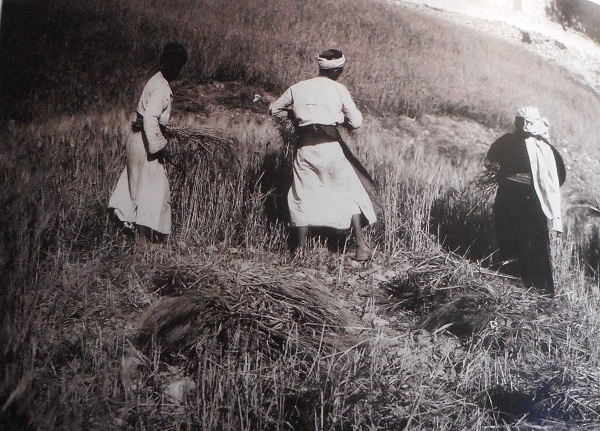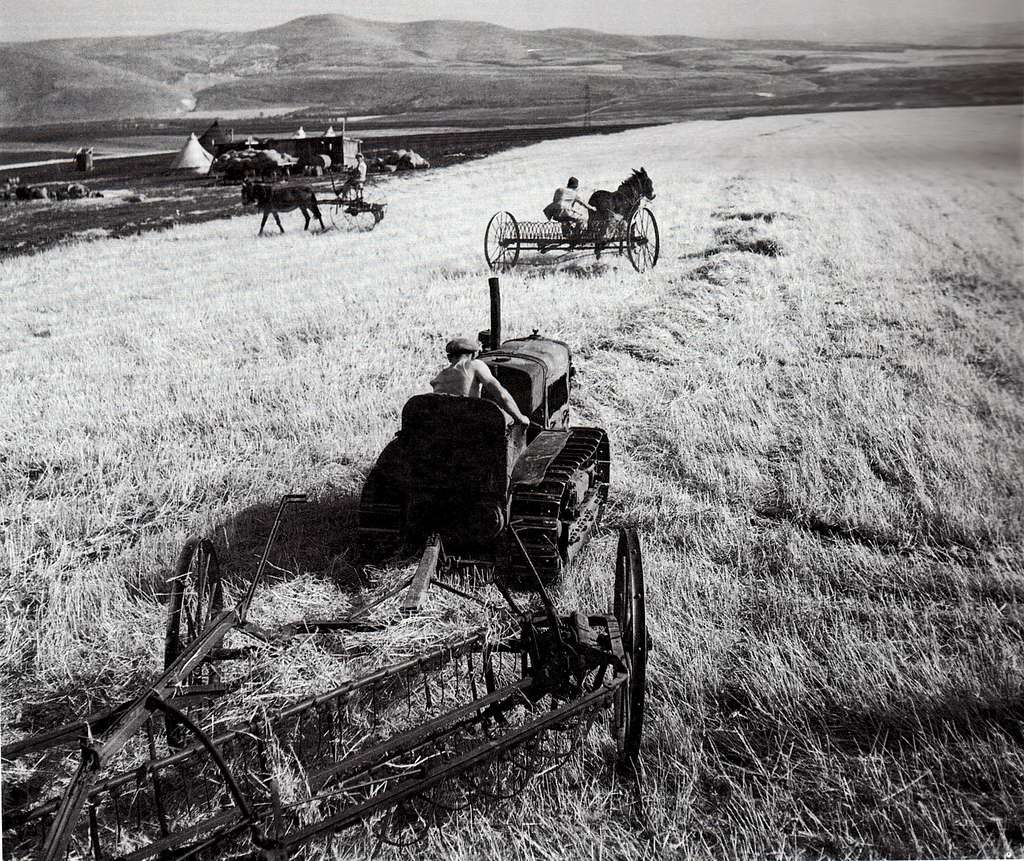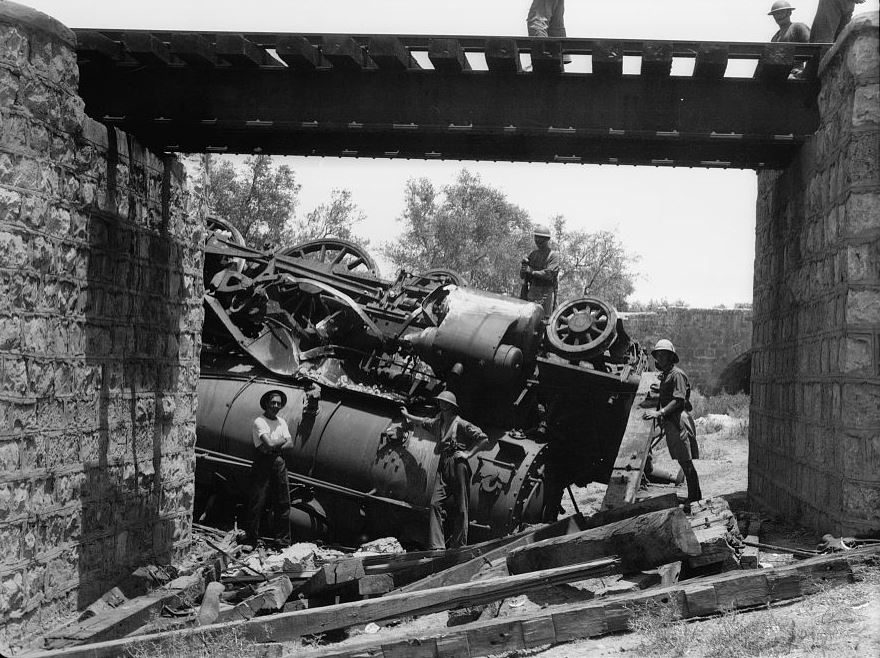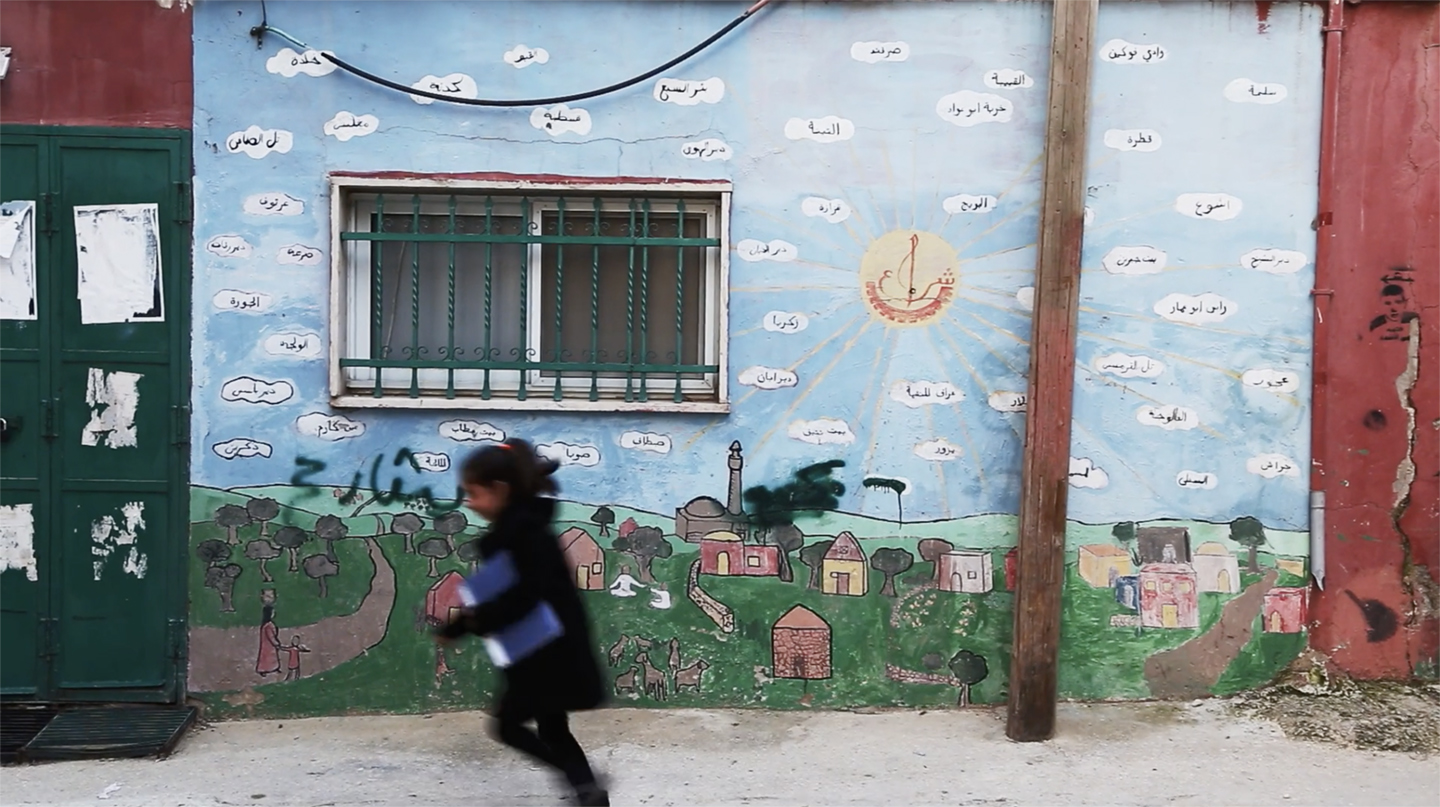Sasha Plotnikova: Could you start with an overview of historic land relations in Palestine, and how they’ve been affected by colonial land reforms?
Jumana Manna: To begin with, and something I have come to appreciate thanks to conversations I’ve had with my father, the historian Adel Manna, it is important to differentiate between the Ottoman Empire and the British Mandate, and not batch these two forms of rule under the same umbrella. The Ottomans instated “land reforms” that were not colonial as such, while the British were colonial administrators, who enforced stricter policies of registration and taxation that would pave the way for Zionist colonization.
Colonial land policies waged a war on Indigenous people’s relationship with the land all over the world — relations which had existed outside of and prior to the modern logics of individual ownership, extraction, and standardization and had embodied philosophies of praxis rather than a strict legal code. Most exemplary of this relation in Palestine was the mushaa’, agricultural common land based on the idea of use-right that was managed by the community living on it. Mushaa’ lands would be used primarily for the cultivation of grains and vegetables and rotated – every few years, for example – to a different family who would cultivate it according to their particular needs, customs, and abilities (manpower).
The mushaa’ was not collectively owned as such, but was actually state land (miri). This practice existed throughout the four centuries of the Ottoman period but under different names. It was a kind of land management reflective of the decentralized rule of the Ottomans that allowed for semi-autonomy in the rural areas where fellaheen (peasants) could manage their own needs in terms of sustenance and security. What the Ottomans cared for was to collect taxes on a village scale (not on an individual or family basis), which fostered a feeling of solidarity amongst the inhabitants of the village.
The Land Code of 1858 and the laws that followed are known as the Ottoman land reforms. They were part of the Tanzimat in the second half of the 19th century that came in response to the financial crisis of the Ottoman Empire, partially due to European colonial expansion. So these reforms aimed at increasing tax revenue, improving living standards – through a capitalist-driven logic of integration into the world market – and enabling the central government to have more administrative control over the provinces.
JM: The Land Code introduced five categories. The largest of them was state land (miri) under which three subcategories were included: the mushaa’ (agricultural), the mawwat, (uncultivated or unappropriated land, desert or rocky areas), and matruke (like forests or swamps, “without an owner,” but matruke often refers to land used for herding, fishing, also roads or cemeteries).
Waqf is another category, also a form of collective practice of land, but one managed by religious authorities. It would include churches, mosques, synagogues, schools, orphanages, communal kitchens, and other institutions. And there’s also certain cases across Palestine where entire villages were waqf land. For example, around Jerusalem, there were sixteen villages that were registered under Haram al-Sharif, the Dome of the Rock. And so rather than going to the Ottoman Sultan, the village’s taxes would go to charity.
The last category was mülk: private land ownership which existed in the cities and in the villages. Somebody’s backyard or garden would be their mülk, for example, and of course people’s houses and the land they stood on.
The Tanzimat introduced a major structural change within Palestinian society, especially amongst rural society, which generally did not register their land until then. Agricultural land relations were based on use-right and right of mobility. When the land reforms were introduced, many peasants were reluctant to register their land claims because they were afraid of becoming entangled with a system that would mean more conscription and taxes. They were afraid their sons would be taken away for wars that they had nothing to do with. Eventually merchant families and other wealthy people registered some of the collectively-used land as their property, and would pay taxes on behalf of the community. With time this process of registration, which gave the possibility of selling the land later, introduced class stratification in Palestine.
Noura Alkhalili: A relevant example of that is Marj Ibn Amir, which is one of the most fertile lands in Palestine, and it’s a big chunk of land. It was sold by the Sursock family, an upper class Lebanese family that in 1860 bought all this land from the Ottoman Empire for a very cheap price because it was almost bankrupt. And then during the British Mandate, they sold this land to Zionist organizations such as the Jewish National Fund and the American Zion Commonwealth.
JM: Exactly. Urban families from Haifa, Jerusalem, Jaffa, Beirut, and Damascus would register lands in the Galilee in particular and other parts of historical Palestine — lands that they never lived on. They were considered “absentee owners.” This was part of the problem later when land was sold to the Zionists in the 1920s and 30s, primarily by families that were not living in Palestine, actually mostly in Beirut. Those owners had little to no relation to the land.
Despite the Tanzimat, Palestinians generally resisted the logics of land registration. The system was also inefficient and many didn’t get the memo or really know how or where to register. According to the historical literature, up until 1917, 70% of Palestine was estimated to still be mushaa’ land. And that’s just the mushaa’, aside from all the other forms of collective land. So, the vast majority of Palestine was not registered as private property before the British Mandate, which then aggressively reduced mushaa’ or other kinds of miri land from 70% to 20–25% by 1947 with the clear intention of encouraging what they called “investment”: in other words, transforming Palestine into a Jewish state.
There’s a clear relationship between the law and colonization, this kind of absurd legal and administrative process that begins with categorization — naming and parceling things as a way to dispossess, divide, and control.
The mushaa’ is a really inspiring framework through which to find approaches and vocabularies that resist capitalist logics of property and settler-colonial or corporate takeover. I think this is why there has been an increased popularity of the topic. It sounds like such a radical idea today that for centuries, Palestinians, or Levantines, practiced a relationship to the land grounded in the belief that certain things should not be privatized and are common heritage, there to serve human survival through cooperation, social reproduction, and communal solidarity. The mushaa’, once framed as backwards by the forces of colonialism, is more democratic and egalitarian than the severe imbalances and miserable exclusions that capitalism has produced.
NA: I would like to briefly highlight that the British colonialists privatized the mushaa’ to make the resources of a colony available for capital accumulation, and particularly to facilitate land transfers to the Zionists, in order to secure a Jewish national home in Palestine, as pledged in the Balfour Declaration of 1917. So the British-Zionist alliance worked together to achieve the Zionist colonization of Palestine. For the Zionist colonizers, their main aim was to attain land by all possible means in order to carry out their settler colonial project.
JM: While Ottoman politics made it difficult for the Zionist movement to register land, the British did the exact opposite. Basically, the British took over what was miri land (state land) from the fallen Ottoman Empire. And then the newly established Israeli state took over from the British who ended their mandate overnight. What this meant was that large swaths of land were taken over by the settler-state – obfuscating varying communal relationships and practices that had taken place on it for centuries – only then to ban Palestinian use-right with the excuse that they were not registered as property. After ’48, the Palestinians who remained would be fined for herding their livestock on so-called state-land, and decades later foragers would be fined for collecting wild growing herbs on their ancestral lands.
NA: Palestinians did not need these land registration documents — they had natural boundaries and oral agreements based on liability, kinship, and social relations. There were no clear demarcations of the borders of the land. Hence, the land is not just a resource, but it’s also a social relation. And until now there are lands in Palestine where the ownership is still not registered.
JM: Historically we managed without it for many hundreds of years.
NA: And that troubled the British; not being able to read the land properly and not knowing who owned it, which directly affected the land transfers to the Zionists. Therefore, waging a war on the mushaa’ and breaking it into private parcels was the way to exert control over it, for the sake of development, and to facilitate the transfer of land to the Zionists.
Just to give you some numbers, by 1947, Zionist ownership did not exceed 6-7% of the land of Palestine, so it wasn’t really that much, and the Jewish population composed less than a third of the entire population. During the British Mandate, the gates of Palestine were open for Zionist settlers to come, but even with this the numbers are not that high.
JM: I think these numbers are important, because they reflect that even with this war on the mushaa’, the Palestinians refused its abolition in so many ways. The majority of land owners did not sell. The majority of Palestine remained in Palestinian hands up until 1947. Israel confiscated most of Palestine through ethnic cleansing, which continues in the West Bank, particularly in the last few decades.
NA: Of course. There were several anti-colonial uprisings in 1921, 1922, and 1929 that culminated in the Great Revolt of 1936-1939, led by the fellaheen and other popular classes, stubbornly determined to defend their land against the British colonial rule and the Zionist colonization.
The fellaheen refused to cooperate with the British officials and surveyors who were touring the villages as a form of resistance against the land settlement system. This took the form of sabotage, such as ruining the equipment of the surveyors and kicking them out of the villages. They managed to halt all these land settlement processes, and the resistance against the enclosures escalated heavily during the Great Revolt, which is considered to be one of the biggest anticolonial uprisings in the region.
SP: This dispossession enabled the Zionist claim that the land was an empty wasteland. How do you see that showing up in the colonial entity’s self-mythology?
JM: By saying that this land does not belong to anybody, it was a way to say “We can take it and improve it.” So the person who “improves” the land in a way that’s recognizable to the colonial European mindset is then entitled to it, which was always the logic of settler colonialism in North America and in other parts of the British Empire. Just as Palestinian modernity was not seen by the British or by the Zionists, rendering indigenous relationships to the land illegible was an effective method of dispossession. Most of the photography that we have of Palestine from the late 19th century and early 20th century is by Orientalist photographers who were coming either with missionaries or later with the colonial powers of France, Britain, and Germany to do biblical research in Palestine and in the Levant at large. The photography that we encounter from that era reproduces this gaze which sees the land as frozen in some kind of biblical time where the human figures are distant and camouflaged, usually with livestock, in a largely “vacant” landscape. The captioning of these images was another layer of erasure, where of course names were often omitted, and the site is referred to by its biblical name or association, rather than its then-current Palestinian signifier or what was actually in the image. This photographic history reflects how the law, in relation to property, works: it sees things through a particular gaze and language, and in so doing erases what’s actually in front of it, the racialized other and their world view. Much like this gaze, the colonial law freezes Palestine into an ancient or timeless past that has no present and is therefore available for expropriation.
SP: There’s this abandonment and abolition of land-based practices that are central to the settler state’s narrative of the land that it occupies. And the notion of abandonment is also at the crux of these contradictions that you both depict in your work. I’m thinking of the “enclosures from below” in Noura’s work, where Palestinians built on mushaa’ and waqf lands so they didn’t look abandoned in the eyes of the Israeli authorities, and in Foragers, one of the characters saying that the plants aren’t growing as much since the Israeli authorities classified them as endangered, and foragers began to face fines for going out to collect the plants. How have land defense tactics evolved in the face of these contradictions?
NA: During my ethnographic fieldwork in 2013-14, I sought to unpack the dynamics between the perceived abandonment of the land that is left unused, and the abandonment of the Palestinian refugees. I worked in two specific areas in and around Jerusalem, where there are two refugee camps: Shu’faat refugee camp (the only one within the municipal boundary of Jerusalem), and Qalandia refugee camp, situated at the edges of Jerusalem, within Area C.
These two refugee camps are entirely excluded behind the separation wall. But even before the erection of the wall, they were abandoned by the Oslo Accords. To briefly give some context, UN Resolution 194 grants the right of return to all Palestinians who became refugees as a consequence of the Nakba – the ethnic cleansing of Palestine – in 1948 or during the 1967 war, as well as to their descendants. And according to the resolution, they have the right to return to their pre-1948 and pre-1967 homes and lands, or to receive compensation if they freely choose not to return. However, until today, Israel denies this right of return.
This has created an expanding population of Palestinian refugees, and following Oslo, they’ve been abandoned by the Palestinian Authority, who has stopped advocating for the right of return and putting pressure on Israel. So the refugees have been left to fend for themselves.
My work centered around the refugees who were once fellaheen – peasant farmers from Palestinian villages where they once practiced the mushaa’ – who are now landless and cramped into very overcrowded camps. I was curious to unpack how they perceived these communal land cultures today. Being a colonized entity under an aggressive, violent settler colonial regime riddles daily life with paradoxes. During the Great Revolt, Palestinians defended the mushaa’ against the enclosures imposed by the British. Now, the paradox is that to keep the remaining mushaa’ within Palestinian hands, the landless refugees need to privatize it, parcel it, and build on it right away. Leaving land unused is risky, as it will be confiscated by the Israeli authorities for the sake of the expansion of the illegal settlements, or so they can convert it into a forest and claim it as state land. And there’s no court where the dispossessed Palestinians could claim their land back, because the whole legal system works against us and in favor of eliminating the presence of Palestinians.
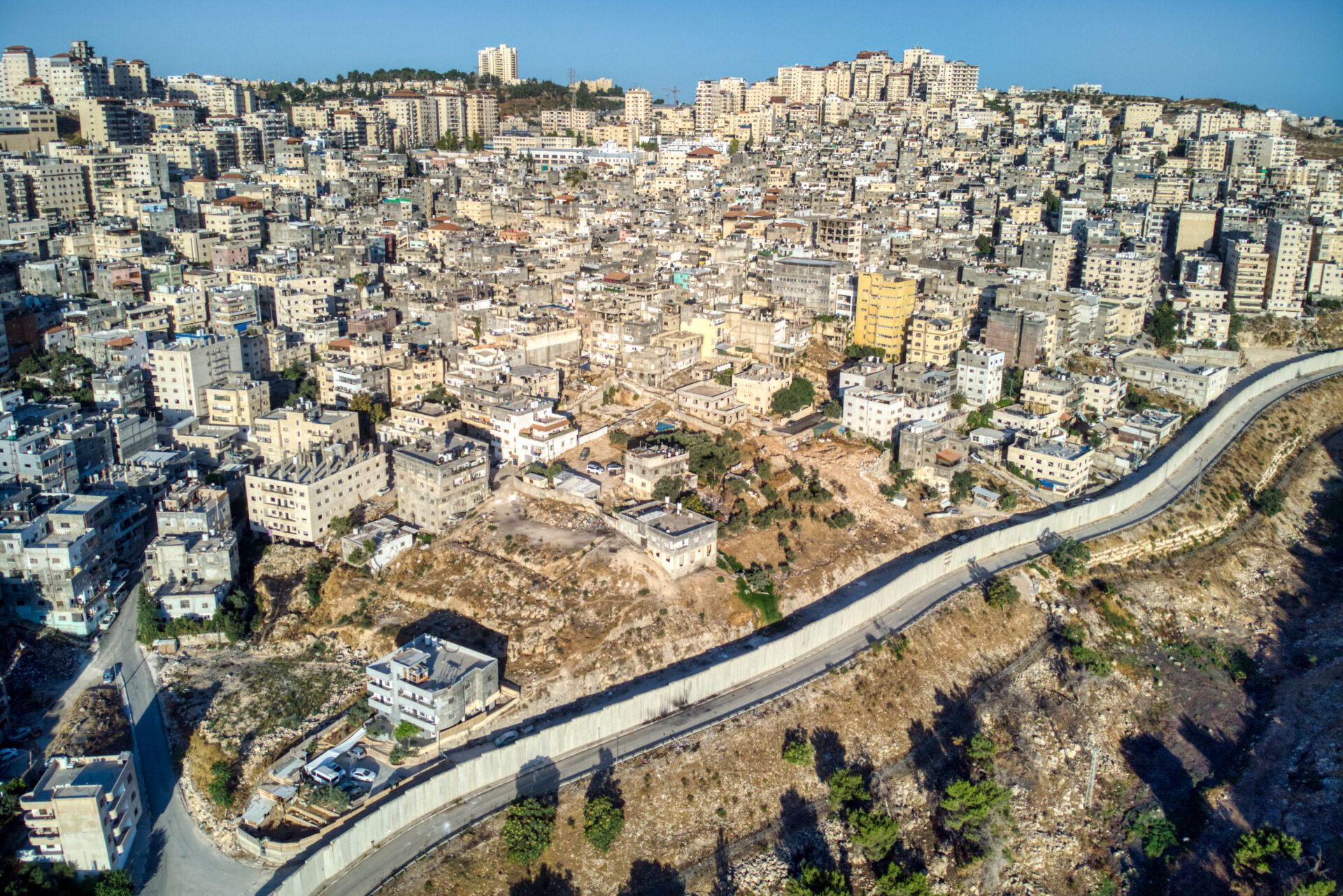
Shu’faat refugee camp surrounded by unlicensed construction, behind the separation wall.
Hagai Agmon-Snir, CC BY-SA 4.0
NA: What I noticed in these specific areas, refugees who claimed to be contractors have the appearance of organizing as a collective because of their numbers, which offer some protection to the individual contractors. The contractors managed to encroach on the remaining mushaa’ and claimed ownership. But this must be understood within a broader settler-colonial context undergoing a process of Judaization in Jerusalem and Area C, where Palestinians are not allowed to build and expand, and to some extent to even exist. So their act of encroaching on the remaining mushaa’ and keeping it within Palestinian hands becomes an act of resistance coupled with survival.
Since the Oslo Accords, the majority of Palestinians are undergoing national impoverishment, and more so for the Palestinian refugees. They have been left to provide for themselves within a Palestinian economy undergoing a distorted neoliberal transformation under Israeli occupation. They had to find ways to survive, and surpass inequalities that are emerging within Palestinian society. One of these ways that I have sought to unpack throughout my research has been the reclamation of the commons, but in absolutely the opposite way of how a common or the mushaa’ is supposed to be practiced.
JM: If you look at the amount of olive tree cultivation in the West Bank, it actually has expanded from 1967 to the present, exactly as a land defense tactic. Like Noura was just explaining, if you leave land unused or not obviously cultivated, it’s going to be expropriated much faster.
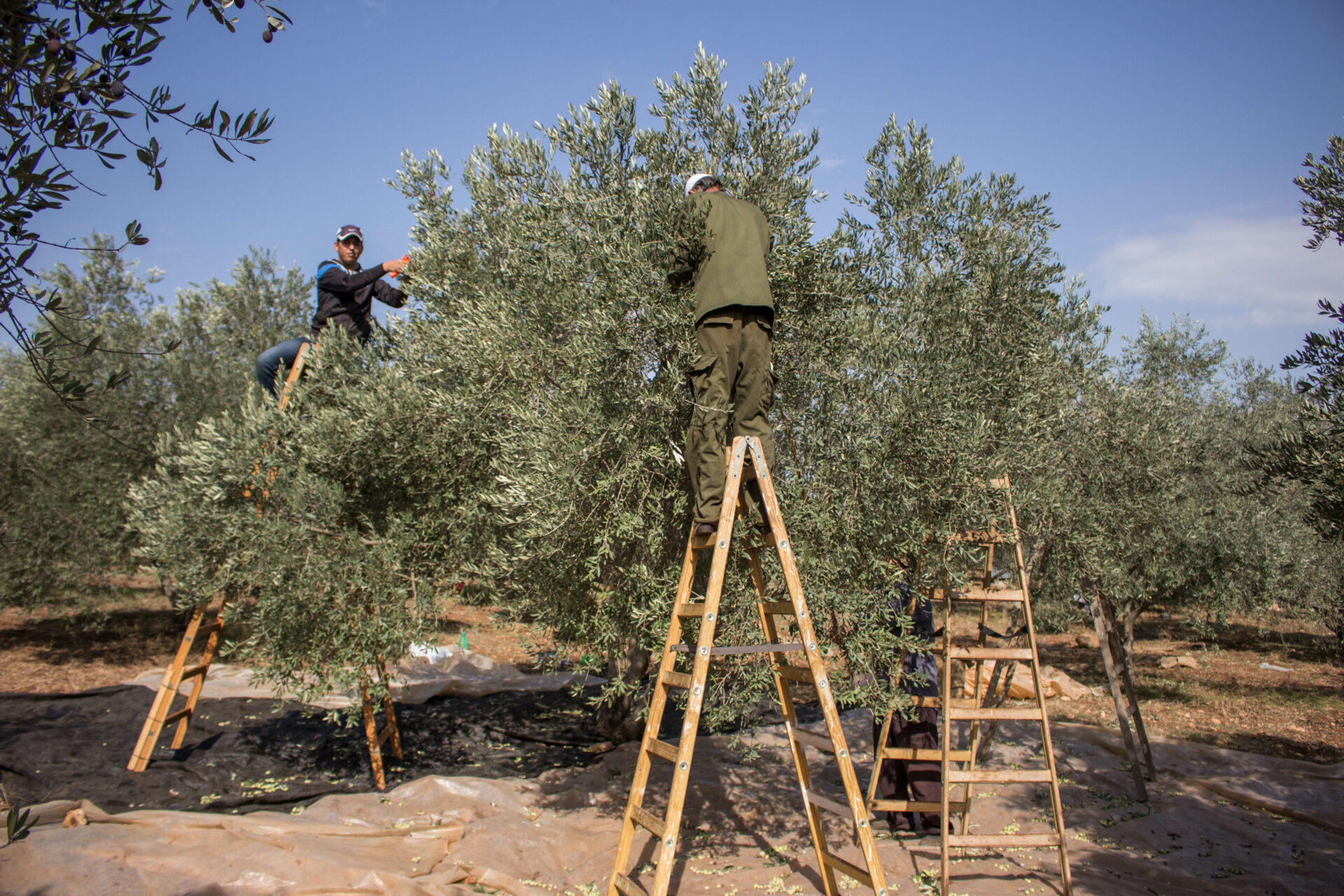
A Palestinian farming family harvests olives near Jenin, November 2015
TrickyH / CC BY-SA 3.0
JM: There’s been such a major transformation of Palestinian society over the past 80 years, but there are still forms of social cohesion that persist in relation to the land and beyond it. For example, prisoners’ solidarity networks, or small businesses and educational institutions striking across West Bank towns to protest and honor martyrs. When I worked on my film Foragers, I was interested in foraging as an ancestral practice that Israel has tried to limit perhaps because it reflects those very deep ties to the land and the knowledge of all that grows from it: what to forage, when (before it blossoms, or after it blossoms), what’s poisonous, the plants’ medicinal properties, the many delicious meals that can be cooked out of “free food.” Palestinians within 48 territories continue foraging even if under the present Israeli legal status the land is not theirs – not in a communal form, not in a private form – it’s been expropriated, confiscated, privatized: an Israeli state practice that continued for decades after the Nakba, with such land today usually belonging to Israeli kibbutzes or some other formation. Foraging belongs to the history of the commons, or the mushaa’, both because it would have been practiced on communally used lands, be they forests, mountains, valleys, et cetera, and because foraging is part of the collective agrarian history and knowledge of the region. This practice has survived and continues to resist. A few people from a village will forage the more difficult plants (harder to find and criminalized) that are desired, like za’atar or ‘akkoub. Despite the risks and the fines involved, they will do this hard work throughout the season to sell to their fellow villagers and surrounding communities. Palestinians are masters of continuity under catastrophic circumstances.
NA: This makes me think that the refugee camp itself is a practice of commoning. The camps started as temporary, but due to the denial of their right of return, the refugees gradually expanded them by reproducing their lost villages. For example, if you go to any refugee camp, the streets or the camp neighborhoods have the names of the villages where the refugees originated from. The original village communities tried to stay together socially and spatially. Thus, kinship, social relations, and political engagement are very strong within the refugee camps.
SP: You’ve both touched on the Oslo Accords as being a turning point for the Palestinian political consciousness. Can you elaborate on how that moment and the ensuing policies shifted the role of land liberation within the Palestinian struggle?
NA: When I spoke to the head of the popular committee in the Shu’faat camp, he told me that in the early 90s, when refugees left the boundaries of the UNRWA camp and privatized the adjacent waqf land and built on it, they created a rupture in the social continuity of the camp. That was the beginning of a class stratification which has intensified since the years of Oslo for Palestinian society as a whole. Neoliberalization has shifted the focus of the struggle from a collective resistance for the liberation of the land towards a project obsessed with building a quasi-state. Meanwhile, Palestinians have become more atomized and individualized. But if we look at the Gaza Strip, we see that under severe conditions, people come back together. When there’s a heightened level of destruction, of massacres, of genocide, I think what enables people to survive is the return to the collective, the caring that people share together, with their strong religious faith.
Prior to the Oslo Accords and particularly during the First Intifada, Palestinians were able to be self-sufficient. As part of their collective struggle against the Israeli occupation, they stopped relying on Israel in a number of ways, but to name a couple: by boycotting Israeli products and not paying taxes, and they survived. The Oslo Accords gave primacy to the security of Israel, with the pursuit of economic growth which enriched the elites (and Israeli economy) and impoverished the majority of Palestinian society. Moreover, the Palestinian Authority was established through the acceptance of spatial apartheid that fragmented the West Bank into enclaves A, B, and C, each of which are under different jurisdictions. The Israeli military fully controls Area C, which constitutes more than 60% of the West Bank and contains most of the agricultural land, such as the Jordan Valley, and natural resources, such as water. We are deprived of water and are denied access to it, so we have to buy water from Israel — water that is stolen from us and from our lands.
JM: I think that’s the bottom line. It went from liberation to state-building and profit.
NA: Yeah, for a very small stratum of Palestinian society. I think the fragmentation is what we suffer most, how the Gaza Strip is completely detached from the West Bank, and the West Bank is entirely separate from Jerusalem, and the fragmentation within the West Bank — there are around 165 enclaves that are not connected because they’re surrounded by Area C, so going from one place to another is arduous, time consuming and unpredictable with checkpoints, surveillance towers and illegal Jewish settlements along the way.
JM: And unfortunately you can see how effective the Israeli tactics of fragmentation are. Each area in historical Palestine has its own set of obstacles to just getting on with everyday life. That’s exactly the point, to divide and rule. You keep everybody busy with their local problems so they don’t even have the capacity to think of liberation or to organize collectively. And yet Palestinians have overcome this in moments like the 2021 Unity Uprising, where for the first time since the Great Revolt of 1936–39 Palestinians across historical Palestine, in the refugee camps, and in the diaspora managed to unite for a general strike. This was an incredible testament to how Israel constantly fails to break the Palestinian will toward liberation. But in practice what we see most of the time is people really just struggling to get by with their basic needs.
NA: Also, we have to note that if you’re a Palestinian who is politically engaged inside Palestine, it’s easy to get arrested and placed under administrative detention, where a person is held without charge or trial and detained without legal proceedings for an unlimited period of time. And we see the treatment of Palestinian prisoners — it’s awful. It’s a tactic to intimidate Palestinians, to prevent them from being politically engaged and organizing collectively. This is very scary for many people. It becomes more like, just think of your own self and focus on being educated and finding a job.
JM: Israel aims to crack down on collective self-determination wherever it emerges. As we see in Gaza, the Israeli occupation army systematically targets those who are distributing food aid or fuel, methodically destroying the healthcare system by bombing hospitals and assassinating medical workers with specializations that require many years of training: genocidal tactics that Palestinian surgeon Ghassan Abu Sitta has called the biosphere of war. Even once a ceasefire is reached, tens of thousands will continue being killed indirectly through injuries, disease, malnutrition or starvation; with limited medical professionals left to treat them. There have already been traces of polio found in sewage water, which the Israeli army was quick to respond to by vaccinating its soldiers, while hundreds of thousands of Gazans are at risk of this highly infectious disease. This is the planned destruction of all aspects of the material and social infrastructure. We’re seeing an unprecedented eliminationist version of Israeli brutality in Gaza. But the tactics are familiar and have been practiced for decades: a carefully planned crippling of Palestinian society. It is a society with a rich history of collective practices, transformed into a consumer society permanently dependent on the occupation, managed and controlled by foreign aid.
SP: Noura, in your article there’s this saying you refer to, “na’mal eih?” (What else can we do?). This reminds me of the stubbornness of the foragers during the interrogation scenes in Jumana’s film. And Jumana, in your work there’s an interest in daily life and how it’s disrupted by these bigger state projects entwined in geopolitics: foraging vs the Israeli legal system, farming vs industrial agriculture (in Wild Relatives). What do you both make of these small-scale refusals, is that part of a culture of anticolonial resistance?
JM: There is a real strength that has been developed as a result of these impossible circumstances Palestinians have faced for four generations. It’s the defiance in saying, to hell with Israel and its laws, we will continue doing what we need to do as we always have. There’s so many examples of the way in which Palestinians refuse and reject the logic of Israel’s technologies of dispossession and oppression. West Bankers and Jerusalemites getting married, despite laws that prevent family reunification. People continue to build homes for their children in East Jerusalem, even though they know they’re going to end up with massive fines, and a likely destruction order of their houses. This spirit of defiance, which at times is not heroic, is simply about remaining present and getting on with things. But then there are those who have given up and are willing to collaborate, either with the PA or with Israel, because they think, Yeah, we’re losing everything anyway. This is what divides Palestinian society today. Nevertheless, the majority of Palestinians find a myriad of methods of resistance and continuity. In a way, that continuity is the goal in and of itself, a kind of insistence on life against all the odds.
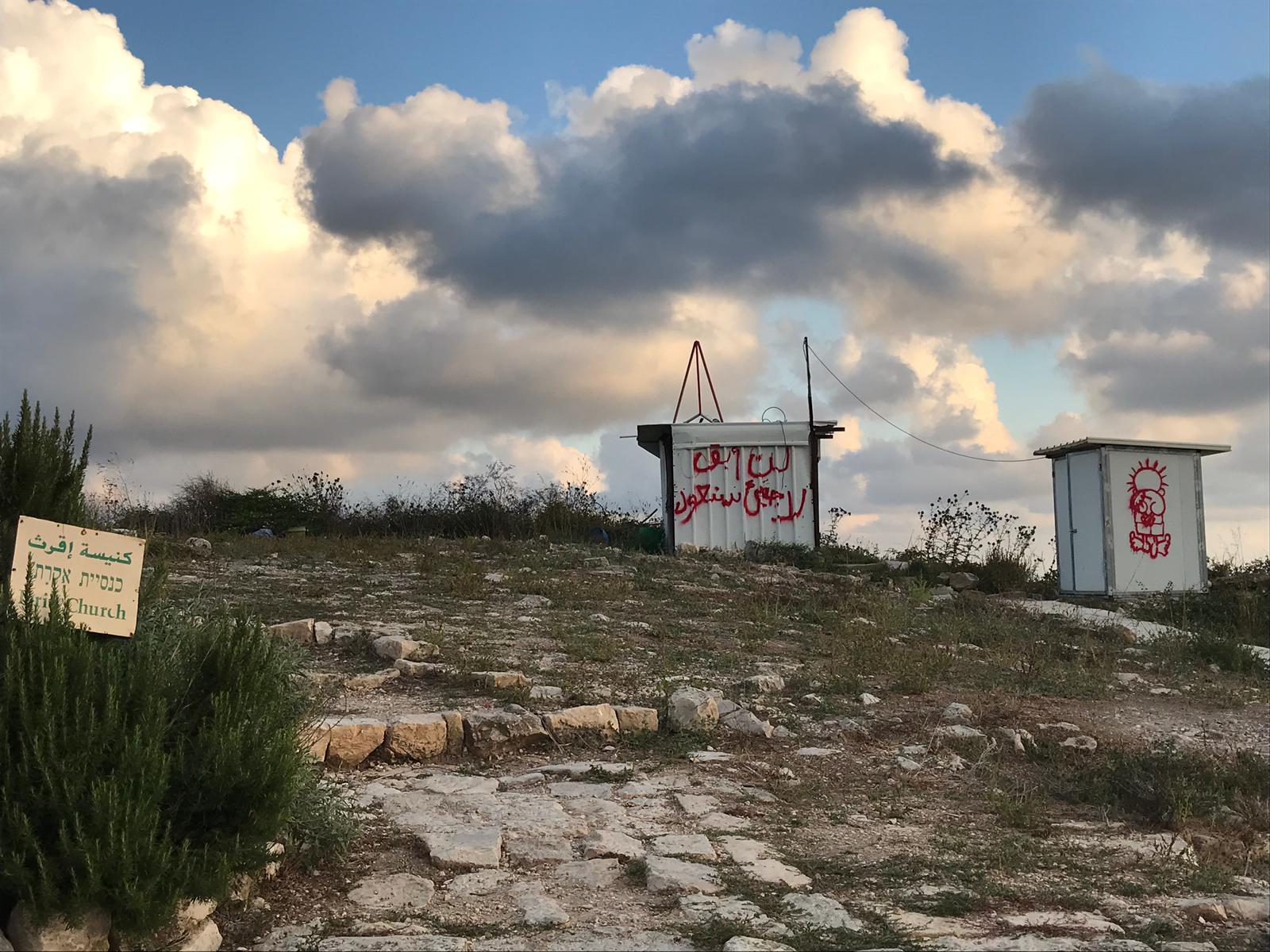
Graffiti depicting Handala and the phrase “I will not remain a refugee, we shall return” in the destroyed village of Iqrith, where a third generation of Nakba refugees has been symbolically returning, December 2019
وفاء خطيب / CC BY-SA 4.0
NA: Yeah. And I also think that there’s not much of a choice. We have to cope with this cruel reality, resist it, and stay put on the land — it’s what we call sumud (steadfastness). Also, there’s this strong connection to Palestine and love of life. It’s ingrained in the connection to the land for the people indigenous to this land. Palestinians often say: “Where are we going to go? This is our home, our ancestral lands, and our culture. It’s where we come from and we’re not going to leave.” I was amazed by the refugees in the Shu’faat refugee camp – with all the misery and the hardships that they face on a daily basis, and with Israel’s constant attempts to obliterate the camp – the refugees repeatedly insisted, “This is our home and the only way we’ll leave is to go back to our original villages.”
It’s time we bring back our discussions on the right of return, if we want to practice decolonization. For example, 70-80% of those who are living in the Gaza Strip are refugees, and the majority of them originate from villages around the Strip and the coastal region up to Yafa (Jaffa). What is known now as the Gaza Strip and the West Bank are colonial formations created by Zionist militias, British colonialists, and the Israeli settler colonial project following the 1948 Nakba in order to erase historical Palestine — to fragment us and prevent the return.
Decolonization and liberation, in my opinion, start with achieving the right of return that brings us back to the land. In certain villages within historical Palestine – Kufr Birim, Iqrith and al-Bassa – the third generation of Palestinians who remained in what became Israel following the Nakba, are symbolically returning back to their original villages that have been destroyed, seeking to reproduce the mushaa’ of the village to reconnect to their roots. And that’s what Palestinians imagine as part of their liberation: to return.
Noura Alkhalili is an Assistant Professor of Human Geography at the Department of Geography, Planning and Environment at Radboud University/ the Netherlands. Her research expertise is situated at the intersection of critical and political geography, urban studies, settler-colonial studies, energy transitions and green extractivism in the MENA region. Noura’s work has appeared in different journals such as Political Geography, Antipode, Settler Colonial Studies and Jerusalem Quarterly. She holds a PhD in Human Geography from Lund University/ Sweden.
Jumana Manna is a visual artist and filmmaker. Her work explores how power is articulated, focusing on the body, land, and materiality in relation to colonial inheritances and histories of place. Through sculpture, filmmaking, and occasional writing, Manna deals with the paradoxes of preservation practices, particularly within the fields of architecture, agriculture and law. Her practice considers the tension between the modernist traditions of categorisation and conservation and the unruliness of ruination, life and its regeneration. Jumana was raised in Jerusalem and lives in Berlin.
Special thanks to Adel Manna for sharing his historical knowledge in preparation of this conversation.

